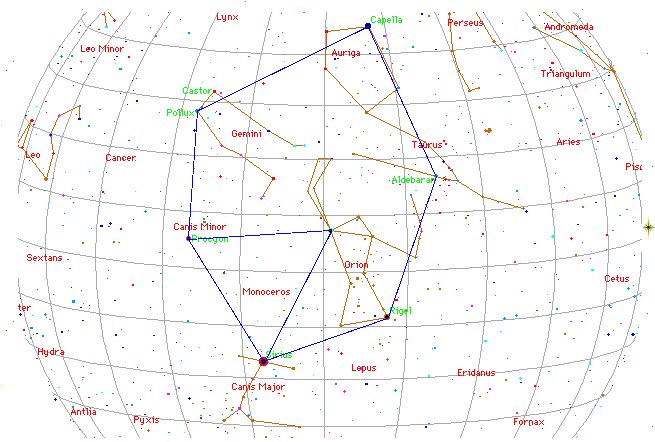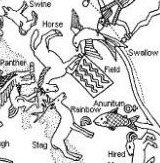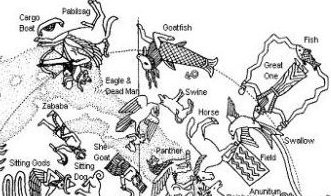197. Once again. Approximately *116 * (26000 / 365.25) = 8257 years before the time of rongorongo (1842 A.D.), i.e. around the year 8257 - 1842 = 6415 B.C., the Eastern One of the Twins (Pollux) had risen together with the Sun at 0h:
The Latin name given to this star was illuminating, because Lux was Light and in Rome the river down on earth which corresponded to the Milky Way River high up above ought to have been Po. Therefore the Greek name Poly-deuces became Po-(ly)-lux. There were many (poly) small lights up in the River. We can read in Hamlet's Mill, for instance: "... That Eridanus was the river Po in northern Italy was a common and simple notion in the Greece of Euripides. In one of his great tragedies (Hippolytus), the chorus yearns for a flight away from the world of guilt, to mountains and clouds, to lands far off: Where the waters of Eridanus are clear // And Phaeton's sad sisters by his grave // Weep into the water, and each tear // Gleams, a drop of amber, in the waves ..."
But the constellation Eridanus in the sky ended at the right foot of Orion and in no way could be imagined as identical with the Milky Way which the unborn souls were using to get down to their next incarnation. ... Men's spirits were thought to dwell in the Milky Way between incarnations. This conception has been handed down as an Orphic and Pythagorean tradition fitting into the frame of the migration of the soul. Macrobius, who has provided the broadest report on the matter, has it that souls ascend by way of Capricorn, and then, in order to be reborn, descend again through the 'Gate of Cancer'. Macrobius talks of signs; the constellations rising at the solstices in his time (and still in ours) were Gemini and Sagittarius: the 'Gate of Cancer' means Gemini. In fact, he states explicitly (I,12.5) that this 'Gate' is 'where the Zodiac and the Milky Way intersect' ... Instead Euripides was pointing upwards to the mountains and to the clouds and this was the opposite direction compared to the way by which the souls were descending. There had to be a way up if there was a way down and the Milky Way indeed described a cycle. The name Po means 'river' in the Italian language and in Latin this was Padus, Greek Eridanos, Ligurian Bodincus = 'without bottom', i.e. the deep or muddy (river), Latin paedus = 'dirty'. Up above the River was as clear as the sweet tear-drops of rain, but below this water gradually became polluted (cfr pollux). "... the Aztecs took Castor and Pollux (alpha beta Geminorum) for the first fire sticks, from which mankind learned how to drill fire. This is known from Sahagún*. * Florentine Codex (trans. Anderson and Dibble), vol. 7, p. 60. See also R. Simeon, Dictionnaire del la Langue Nahuatl (1885) s.v. 'mamalhuaztli: Les Gemeaux, constellation', who does not mention though, that Sahagún identified mamalhuaztli with 'astijellos', fire sticks. Also, the Tasmanians felt indebted to Castor and Pollux for the first fire (see J. G. Frazer, Myths of the Origin of Fire [1930], pp. 3f.). Considering that the equinoctial colure of the Golden Age ran through Gemini (and Sagittarius), the fire sticks in Gemini offer a correct rhyme to a verse in a Mongolian nuptial prayer which says: 'Fire was born, when Heaven and Earth separated', in other words, before the falling apart of ecliptic and equator there was no 'fire', the first being kindled in the Golden Age of the Twins." Once upon time the separation (falling apart) of sky and earth (ecliptic and equator) would have occurred where the Milky Way ended at the northern spring equinox, but since then this time of the year had been pushed forward: ... Far away, the Mangaians of old (Austral Islands, Polynesia), who kept the precessional clock running instead of switching over to 'signs', claim that only at the evening of the solstitial days can spirits enter heaven, the inhabitants of the northern parts of the island at one solstice, the dwellers in the south at the other ... Considering the fact that the crossroads of ecliptic and Galaxy are crisis-resistant, that is, not concerned with the Precession, the reader may want to know why the Mangaians thought they could go to heaven only on the two solstitial days. Because, in order to 'change trains' comfortably, the constellations that serve as 'gates' to the Milky Way must 'stand' upon the 'earth', meaning that they must rise heliacally either at the equinoxes or at the solstices. The Galaxy is a very broad highway, but even so there must have been some bitter millenia when neither gate was directly available any longer, the one hanging in midair, the other having turned into a submarine entrance ... At the time when Hyadum II had risen with the Sun at 0h the date MAY 16 (136) had been where Pollux rose heliacally. 60 right ascension days later, at the time of Gregory XIII, the date had moved ahead in the Sun calendar to ºJuly 15 (196 = 136 + 60).
But at the time of rongorongo May 16 was where Alcyone (together with Pleione and Atlas) rose with the Sun:
Rain (-drops) fell on the mountain tops and the glyph type ua evidently could have been used to illustrate this phenomenon. The upper part of Ga2-26 would then correspond to 'high up':
... And long did they consider further. At the end of a time no man can measure the five decided that Rangi and Papa must be forced apart, and they began by turns to attempt this deed. First Rongo ma Tane, god and father of the cultivated food of men, rose up and strove to force the heavens from the earth. When Rongo had failed, next Tangaroa, god and father of all things that live in the sea, rose up. He struggled mightily, but had no luck. And next Haumia tiketike, god and father of uncultivated food, rose up and tried without success. So then Tu matauenga, god of war, leapt up. Tu hacked at the sinews that bound the Earth and Sky, and made them bleed, and this gave rise to ochre, or red clay, the sacred colour. Yet even Tu, the fiercest of the sons, could not with all his strength sever Rangi from Papa. So then it became the turn of Tane mahuta. Slowly, slowly as the kauri tree did Tane rise between the Earth and Sky. At first he strove with his arms to move them, but with no success. Then he placed his shoulders against the Earth his mother, and his feet against the Sky. Soon, and yet not soon, for the time was vast, the Sky and Earth began to yield. The sinews [uaua] that bound them stretched and ripped. With heavy groans and shrieks of pain, the parents of the sons cried out and asked them why they did this crime, why did they wish to slay their parents' love? Great Tane thrust with all his strength, which was the strength of growth. Far beneath him he pressed the Earth. Far above he thrust the Sky, and held them there ... Although Metoro never said uaua in his translations of the rongorongo texts Bishop Jaussen showed him it cannot be ruled out that the basic meaning of the ua type of glyph included the idea of keeping together 'in close embrace'. ... In South America the rainbow has a double meaning. On the one hand, as elsewhere, it announces the end of rain; on the other hand, it is considered to be responsible for diseases and various natural disasters [dis-aster]. In its first capacity the rainbow effects a disjunction between the sky and the earth which previously were joined through the medium of rain. In the second capacity it replaces the normal beneficient conjunction by an abnormal, maleficient one - the one it brings about itself between sky and earth by taking the place of water ...
And then we can perceive Ga2-26 as illustrating the idea of separating, like the picture of the Babylonian Rainbow where only the upper part of the 'embrace' remained. We should also notice that the upper part of Ga2-26 is different from that of Ca4-20 which in turn appears to be like the bottom part of ua inverted:
Possibly Cb4-20 represented not heliacal Pollux but the heliacal Flying Eagle (Altair), when at the time of rongorongo right ascension day 4 * 29½ = *118 could be seen where φ Gemini was close to the Full Moon.
The vaha mea (red opening) on Easter Island should be at the other side of the year (sky) compared to the situation north of the equator and we know that the C text probably was beginning where Sirrah together with 0h were at the Full Moon. Therefore tagata noho i to mea could mean the Sun was here building a canoe, similar to the Babylonian Cargo Boat. As observed from a place south of the equator Corona Australis would not be perceived as upside down:
|
||||||||||||||||||||||||||||||||||||||||||||||||||||||||||||||||||||||||||||||||||||








